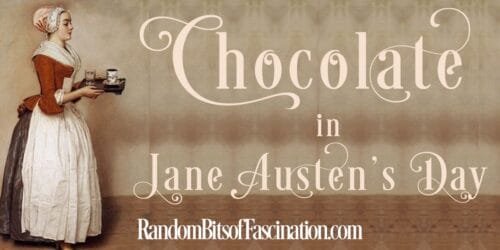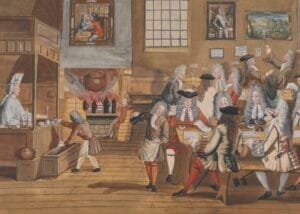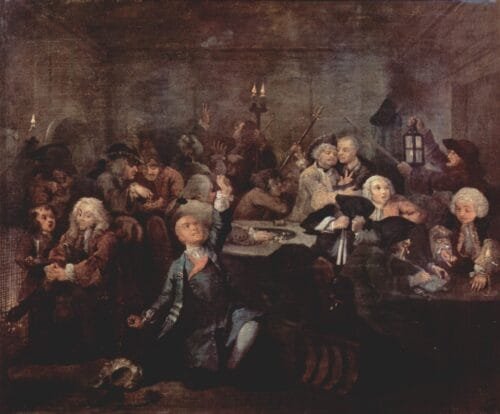English Chocolate Houses

Today is World Chocolate Day! What better way to celebrate than with a trip to English Chocolate Houses.
While chocolate seems ubiquitous today, it did not make its official debut in England until the 1650s when it became very popular in the English Royal Court. Click here to read more about that.
A mysterious, exotic drink from the new world, chocolate vied with coffee for status, popularity and a place in English society. Most historians identify the first coffee house in England as one run by a Frenchman on Queen’s Head Alley just off Bishopsgate, in 1657. Dr. Matt Green suggests that “someone called John Dawkins, living near the Vine Tavern in Holborn, offered chocolate ‘at reasonable rates’ as early as 1652.” (Cocking, 2018)

Early advertising aimed at attracting new guests to the chocolate houses touted chocolate as “an excellent West India drink”, possessing “excellent qualities so esteemed in all places” and able to “cure and preserve the body of many diseases” (Coe and Coe 165). “(T)he popularity of both (coffee and chocolate) was bolstered by pseudo-scientific marketing ploys. Coffee became synonymous with sophistication … and coffee houses became popular places for people of various social standings to discuss business, politics, and science.… Chocolate, as the more expensive, exclusive substance, was imbued with “powerful and infallible” aphrodisiacal properties. Samuel Pepys, the famed diarist and member of parliament, even hailed it as a hangover cure. Movers and shakers clamored to get their hands on it, even in the early days, when the chocolate was likely bitter or sour.“ (Cocking, 2018)
It did not take long for chocolate houses to proliferate and become known as places for people to socialize and enjoy a variety of chocolate beverages.
The chocolate house experience
By 1663, London boasted 82 coffee houses. By 1700, the total had risen to 500. “Unlike Paris and Madrid, where chocolate was reserved for the socially elite, anyone with sufficient money could enjoy chocolate in the British houses. Affordable and accessible to Britain’s large population of middle-class shopkeepers and businessmen, the rise of the chocolate house “democratized” chocolate in Britain.” (Choat, 2013)

To help develop the middle-class market for chocolate, purveyors of chocolate printed and distrusted pamphlets and broadsides touting the health benefits of chocolate as well as painting chocolate, as well as coffee and tea, as the antithesis of alcoholic drinks, pleasurably heightening one’s awareness, rather than dulling the senses.
Aesthetically, chocolate houses differed from taverns or pubs. Frequently decorated with bookshelves, mirrors and good furniture, the atmosphere appealed to the Enlightenment sensibilities. Admission to these orderly establishments often cost a penny, which gave the patron the right to rifle through the newspapers provided and take a place at a table for chocolate and polite conversation. Chocolate, of course would be paid for separately.
Chocolate houses served a very particular sort of warm, sweet chocolate unique to England society.
What sort of chocolate?
In its original form in the New World, chocolate was cold, bitter, and often very spicy. As it passed through Europe, it was adapted to national tastes. Once in English hands, sugar and eggs (as emulsifiers,) were added to the cocoa that was whipped into heated water, milk, cream, and/or wine. A variety of spices, according to ones tastes also be added. A special chocolate mill would be used to whip a froth to top the pot of chocolate, one of the special trademarks of drinking chocolate.
In addition to chocolate to drink on the premise, chocolate houses might also sell blocks of prepared chocolate that people could use to make drinking chocolate at home. To better understand just how much of a convenience this might be, check out this article.
Chocolate and Politics
Chocolate houses were places “where one hears what is and what is believed to be new, be it true or false”, the reputation of chocolate-houses spread as an ideal gathering place for political and social interaction (Coe and Coe 167). News, rumors, and gossip circulated within and between coffee houses carried in and out by the patrons. Often people would select chocolate houses that reflected their interests or political viewpoints.

Before it was an exclusive gentleman’s club, White’s was Mrs. White’s Chocolate House, opened in 1693 by Italian immigrant, Frances White. It became the unofficial home to the Whigs. While The Cocoa Tree and Ozinda’s served the Tories. (Art, Stephen) The Cocoa Tree supposedly had a secret escape route for Jacobites to escape capture by authorities. (Choate, 2013)
Politics were hardly the only form of amusement at chocolate houses, though. Many served food as well as offered space to see and be seen whilst enjoying the pleasure of gossip and gambling.
Chocolate and society
In their day, chocolate houses were probably more famous for their social overtones than their political ones. Though chocolate might have been commercially available to anyone, the location of many chocolate houses in St. James Square (an especially aristocratic neighborhood) rendered chocolate a rather elite drink, drunk among very exclusive company.
Arguably, the most famous chocolate house, White’s was so renowned for its debauched goings, it was dubbed “the most fashionable hell in London.” Several of Hogarth’s Rake’s Progress paintings, depicting patrons at White’s. (Choate 2013)
By the end of the 18th century, London’s chocolate houses began to disappear, many of the more fashionable ones, including White’s, became exclusive gentlemen’s clubs.
Want more about Regency Era Chocolate? Click here.
References
Art, Stephen. Coffee-Houses of the Eighteenth Century. Website of Pascal Bonenfant. https://www.pascalbonenfant.com/18c/clubs/jt_coffeehousesoftheeighteenthcentury.html
Choat, Isabel. A chocolate tour of London: a taste of the past. The Guardian. December 23, 2013. https://www.theguardian.com/travel/2013/dec/23/chocolate-tour-of-london
Chocolate Houses Then and Now. Chocolate Class. March 13, 2015. https://chocolateclass.wordpress.com/2015/03/13/chocolate-houses-then-and-now/
Chocolate in England: Available to all. Enjoyed by few. Chocolate Class. February 29, 2016. https://chocolateclass.wordpress.com/2016/02/19/chocolate-in-england-available-to-all-enjoyed-by-few/
Chocolate, Politics and Gambling. Chocolate Class. February 20, 2015 . https://chocolateclass.wordpress.com/2015/02/20/chocolate-politics-and-gambling/
Cocking, Lauren. The Rambunctious, Elitist Chocolate Houses of 18th-Century London. Atlas Obscura. November 28, 2018 https://www.atlasobscura.com/articles/history-of-gentlemens-clubs
Coe, Sophie D. The True History of Chocolate. 3rd ed. New York: Thames & Hudson, 2013.
Coe, Sophie D., and Michael D. Coe. The True History of Chocolate. New York: Thames and Hudson, 1996.
Enlightenment Era Chocolate Houses Chocolate Class. March 12, 2017 https://chocolateclass.wordpress.com/2017/03/12/enlightenment-era-chocolatecoffee-houses/
The Role of English Chocolate Houses. Chocolate Class. February 19, 2016 https://chocolateclass.wordpress.com/2016/02/19/the-role-of-english-chocolate-houses/

Pingback:Bake up some Historic Chocolate Cookies - Random Bits of Fascination